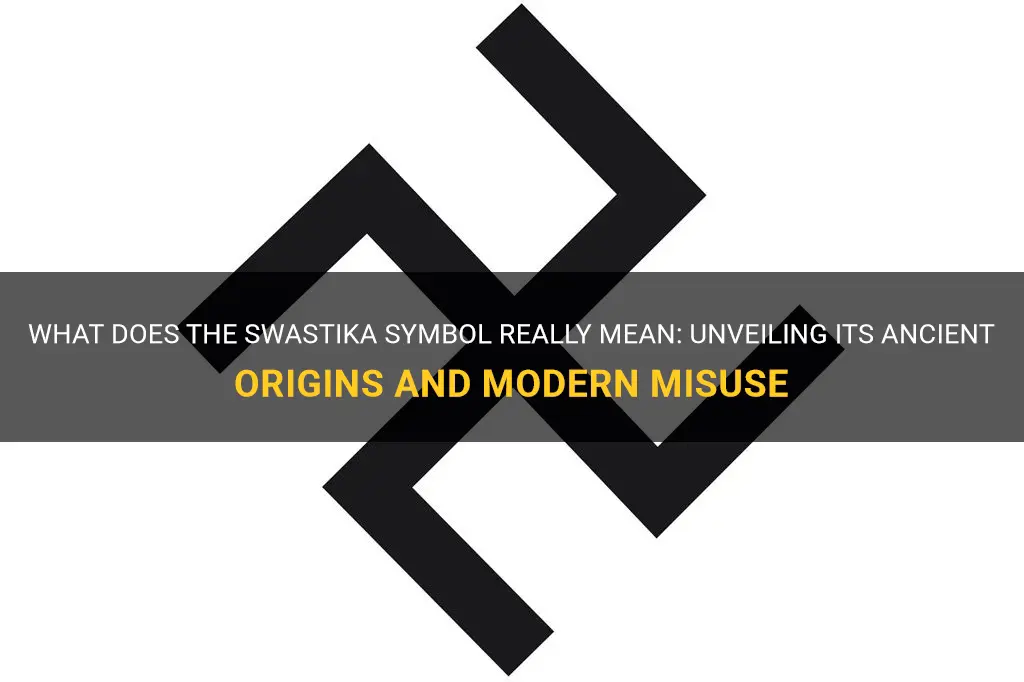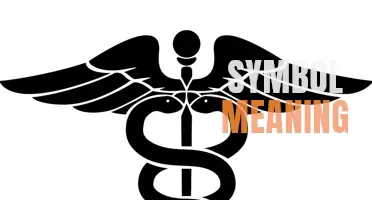
The swastika symbol holds a history that spans thousands of years across diverse cultures, representing various meanings and ideologies. From its beginnings as a religious symbol in ancient civilizations to its devastating association with the Nazi party in the 20th century, the swastika's significance reveals a complex tapestry of human beliefs, traditions, and the power of symbols. Join me as we delve into the intricate journey of the swastika, exploring its diverse interpretations throughout history and the profound impact it continues to have on our world today.
What You'll Learn
- What is the historical significance of the swastika symbol?
- How did the swastika symbol become associated with Nazi Germany?
- What are the different meanings of the swastika in different cultures?
- How has the perception and interpretation of the swastika symbol changed over time?
- How does the swastika symbol continue to impact society and cultural understanding today?

What is the historical significance of the swastika symbol?
The swastika is a symbol that has a long and complex history. While it is most commonly associated with the Nazi Party and their use of the symbol during World War II, the swastika predates this by thousands of years and has been used in various cultures throughout history.
The swastika is an ancient symbol that has been found in archaeological sites dating back over 5,000 years. It is one of the oldest symbols in human history and has been used in many different civilizations, including in India, China, Japan, and various Native American tribes.
In Sanskrit, the word "swastika" means "well-being" or "good fortune." In Hinduism, the swastika represents the sun, prosperity, and good luck. It is considered a sacred symbol and is often used in religious ceremonies and decorations. The symbol is also associated with the god Vishnu and is used to mark the opening pages of Hindu texts.
In Buddhism, the swastika is used as a symbol of the Buddha's footprints or as a representation of the Buddha's heart. It is seen as a sign of spiritual awakening and enlightenment. The swastika is often found on Buddhist statues, temples, and religious artifacts.
In Native American cultures, the swastika is known as the "whirling log" and is used in various ceremonial and religious contexts. It is believed to represent the four cardinal directions and the cycle of life, death, and rebirth.
Despite the swastika's positive historical significance, its association with the Nazi Party has overshadowed its ancient roots. In the 20th century, the swastika was adopted by Adolf Hitler and the Nazi Party as their emblem. The Nazi swastika was tilted at a 45-degree angle and represented their ideology of racial purity and supremacy.
The Nazi's use of the swastika has had a profound impact on its perception and meaning. Today, the swastika is widely seen as a symbol of hate, violence, and genocide. It is banned in many countries and is considered a hate symbol by various organizations and communities.
However, it is important to remember that the swastika predates its association with the Nazi Party. It has a long history and cultural significance that should not be forgotten or ignored. The symbol continues to be used in many cultures around the world in a non-negative context.
In an effort to reclaim the swastika from its Nazi association, some communities and organizations are working to promote its original meaning and positive connotations. They aim to educate and raise awareness about the symbol's ancient history and significance, emphasizing its original symbolism of peace, good luck, and spiritual awakening.
The swastika symbol is a powerful example of how the meaning of a symbol can be distorted and manipulated over time. While its association with the Nazi Party will always be a part of its history, it is important to recognize and respect its original cultural significance and the positive meanings it has held for thousands of years.
The Hidden Symbolism Behind Club Symbols and Their Meanings
You may want to see also

How did the swastika symbol become associated with Nazi Germany?
The swastika symbol, an ancient symbol of good luck and well-being in many cultures, became associated with Nazi Germany during the rise of Adolf Hitler and the Nazi Party in the early 20th century. The swastika, which had been used for centuries in various cultures around the world, was adopted and distorted by the Nazis to represent their ideology of Aryan supremacy and racial purity.
The Nazi Party, led by Adolf Hitler, rose to power in Germany in the 1930s and quickly began implementing their radical and racist agenda. Seeking to create a new Germanic empire based on the myth of a superior Aryan race, the Nazis needed a symbol to represent their ideology. The eventually settled on the swastika, which they believed was a symbol of Aryan purity and power.
The swastika itself had been used in many cultures for thousands of years before the Nazis appropriated it. In Hinduism, Buddhism, and Jainism, the swastika represented good luck, auspiciousness, and the eternal cycle of birth and death. It was also used by Native American tribes, ancient Egyptians, and even by early Christian churches in Europe. The symbol had no inherent connection to racism or hate.
However, the Nazis took the swastika and perverted its meaning. They rotated the symbol by 45 degrees, turning it from a benign, auspicious mark into a menacing one. They also combined it with their own colors and design elements to create the official Nazi flag, known as the Hakenkreuz.
Hitler and the Nazi Party used the swastika as a powerful propaganda tool to rally support for their racist ideology. They plastered the symbol on flags, uniforms, buildings, and other propaganda materials. It became a ubiquitous symbol of Nazi Germany, representing not only Hitler's ideology but also the oppressive regime and atrocities committed by the Nazis.
The swastika's association with Nazi Germany has had lasting effects. After World War II, the symbol became universally recognized as a representation of hate, racism, and genocide. It is now outlawed in many countries, including Germany, where displaying the swastika is a criminal offense. The Nazi's appropriation of the swastika has forever tarnished its original meaning and rendered it a symbol of hate and intolerance.
In conclusion, the swastika symbol became associated with Nazi Germany through the deliberate appropriation and distortion of an ancient symbol of good luck and well-being. Adolf Hitler and the Nazi Party used the swastika as a powerful propaganda tool to represent their ideology of Aryan supremacy and racial purity. The association of the swastika with the Nazi regime has had lasting consequences, forever changing the perception of the symbol and making it a universally recognized symbol of hate and intolerance.
Exploring the Mystical Pegasus: Unveiling the Symbolic Meanings
You may want to see also

What are the different meanings of the swastika in different cultures?
The swastika is a symbol that has been used for thousands of years by various cultures around the world. It is a symbol that holds different meanings depending on the cultural context in which it is used.
In Hinduism, the swastika is considered a sacred symbol and is associated with the god Ganesh, who is known as the remover of obstacles. The symbol is often used in religious rituals and ceremonies, and it represents good luck, prosperity, and well-being. The swastika is also used to mark the opening pages or cover of Hindu texts, as it is believed to bring good fortune and protection.
In Buddhism, the swastika is seen as a symbol of the Buddha's teachings and represents the endless cycle of life, death, and rebirth. It is often used as a decorative element in Buddhist temples and is associated with spiritual enlightenment and the pursuit of inner peace.
In Native American cultures, the swastika symbolizes the four sacred directions – north, south, east, and west. It represents the harmonious balance between the physical and spiritual worlds and is often used in ceremonies and rituals to invoke the blessings of the four winds.
However, it is important to note that the swastika's association with Nazi Germany during World War II has significantly tarnished its image. The Nazis adopted the symbol as their emblem and used it to promote their ideology of Aryan supremacy and hatred towards minority groups. This association has understandably caused widespread offense and led to the swastika being banned in many countries.
It is crucial to differentiate between the ancient religious and cultural meanings of the swastika and its association with the Nazi regime. The swastika has a rich and varied history that spans across different civilizations and should not be solely defined by its misuse by the Nazis.
Today, efforts are being made in many countries to reclaim the swastika's original meaning and separate it from its Nazi connotations. Organizations and individuals are working to educate the public about the symbol's ancient origins and to promote its use in its original context.
In conclusion, the swastika has different meanings in different cultures. It is a symbol that represents good luck, prosperity, and spiritual enlightenment in Hinduism and Buddhism. In Native American cultures, it symbolizes harmony and balance. However, it is crucial to recognize and acknowledge the very real pain and offense caused by its association with the Nazis. By understanding the diverse meanings of the swastika, we can foster a more nuanced and respectful dialogue about this ancient symbol.
The Deeper Meaning of Wind Symbols: Unlocking the Mysteries of the Elemental Force
You may want to see also

How has the perception and interpretation of the swastika symbol changed over time?
The swastika symbol, an ancient symbol that has been used by various cultures for thousands of years, has undergone a dramatic change in perception and interpretation over the course of history. Originally a symbol of good luck and auspiciousness, the swastika has become forever associated with the atrocities committed by the Nazi regime during World War II.
The swastika symbol has its roots in ancient Indian and East Asian religions. In these cultures, the swastika was seen as a symbol of good fortune, prosperity, and well-being. It was often used in religious ceremonies, artwork, and architecture. The word "swastika" itself is derived from the Sanskrit word "svastika", which means "well-being".
However, in the early 20th century, Adolf Hitler and the Nazi Party adopted the swastika as their emblem. They inverted the symbol, so that it was tilted at an angle, and incorporated it into their flag. The Nazis used the swastika as a symbol of their fascist ideology, which aimed to create a racially pure society. They associated the swastika with Aryan superiority and used it as a rallying symbol for their anti-Semitic and genocidal policies.
As a result of its association with the Nazi Party, the swastika has become one of the most stigmatized symbols in modern history. It is universally recognized as a symbol of hate, anti-Semitism, and genocide. The horrors of the Holocaust have forever linked the swastika with the atrocities committed by the Nazis, and it is now illegal to display the swastika in many countries, including Germany.
In recent years, there have been efforts to reclaim the swastika and restore its original meaning. Some Hindu and Buddhist communities have argued that the swastika should be understood in its original context, separate from its Nazi association. They argue that the symbol has a rich cultural and religious history that predates its misuse by the Nazis.
However, the majority of people still associate the swastika with the horrors of the Holocaust. For many, it is a deeply offensive and triggering symbol that represents intolerance, hatred, and violence. It is a reminder of the millions of lives lost and the suffering inflicted during World War II.
In conclusion, the perception and interpretation of the swastika symbol has changed dramatically over time. What was once seen as a symbol of good luck and auspiciousness has become forever associated with the evils of the Nazi regime. While there have been efforts to reclaim the swastika and restore its original meaning, the majority of people still view it as a symbol of hate and genocide. The swastika serves as a chilling reminder of the horrors of the Holocaust and the dangers of intolerance.
Exploring the Symbolism of Music: Unlocking the Hidden Meanings Behind Musical Symbols
You may want to see also

How does the swastika symbol continue to impact society and cultural understanding today?
The swastika symbol, historically used as a religious and auspicious symbol in many cultures, has unfortunately become synonymous with hate, discrimination, and the atrocities committed during World War II. This symbol, adopted by the Nazi regime and prominently displayed on the flag of Nazi Germany, is now widely associated with the Holocaust and the Nazi ideology of racial superiority.
Despite its dark history, the swastika symbol continues to impact society and cultural understanding today. Its presence and usage evoke strong emotions, particularly among Jewish communities and other groups targeted by the Nazis. For many, it serves as a painful reminder of the millions of lives lost and the systemic persecution endured during this dark period in history.
One way the swastika symbol continues to impact society is through the rise of neo-Nazi and white supremacist groups. These extremist organizations frequently use the swastika as a rallying symbol, promoting hate and discrimination. Their presence and activities can lead to a rise in hate crimes and violence, often targeting marginalized communities. In this sense, the swastika symbol represents a direct threat to social harmony and equality.
The continued use of the swastika symbol also poses challenges for cultural understanding. Due to its association with Nazi Germany, the swastika has been banned or restricted in several countries, including Germany, Austria, and Israel. This can create a dilemma when encountering artifacts or symbols from cultures where the swastika holds religious or historical significance. It becomes essential to approach these instances with sensitivity and nuance, recognizing that the symbol may carry different meanings depending on its cultural context.
Efforts have been made to reclaim the swastika symbol from its Nazi connotations. Some organizations and individuals advocate for a distinction between the Nazi swastika, which has a right-facing orientation, and the original, ancient symbol used in various cultures. They argue that the Nazi version should be rejected while acknowledging the deeper history and positive meanings associated with the symbol in different traditions.
However, despite these attempts, the swastika's association with Nazi Germany remains deeply ingrained in public consciousness. Its usage, especially if displayed without context, is almost universally seen as offensive and provocative. Healing the wounds inflicted by the Nazi regime is a complex and ongoing process, one that requires education, remembrance, and building a society that actively rejects hate.
In conclusion, the swastika symbol, once an auspicious symbol in many cultures, continues to impact society and cultural understanding today. Its association with the atrocities of World War II and the Nazi regime has created deep scars that have yet to heal entirely. The symbol's use by extremist groups perpetuates hate and discrimination, while its restricted usage raises challenges for cultural understanding. Navigating the swastika's complex legacy requires acknowledging its painful history and finding ways to combat the ideologies it represents.
Exploring the Intriguing Symbolism Behind the Berserker Symbol
You may want to see also
Frequently asked questions
The swastika symbol has different meanings depending on the cultural context in which it is used. In Hinduism, Buddhism, and Jainism, the swastika represents auspiciousness, good fortune, and well-being. It is considered a sacred symbol and is often used to mark holy places or objects.
Unfortunately, the swastika has also been adopted by hate groups and was prominently used by the Nazi Party in Germany during World War II. Adolf Hitler and the Nazis distorted the symbolism of the swastika and used it as their emblem, associating it with their racist and anti-Semitic ideologies. This association with hate and genocide has led to the swastika being widely seen as a symbol of hatred and intolerance today.
The legality of displaying the swastika symbol varies by country. In some countries, such as Germany, Austria, and France, it is illegal to display the swastika in public due to its association with Nazi ideology and the atrocities committed during World War II. However, in other countries, especially those with Hindu, Buddhist, or Jain populations, the swastika is still used in religious and cultural contexts and is not associated with hate.







